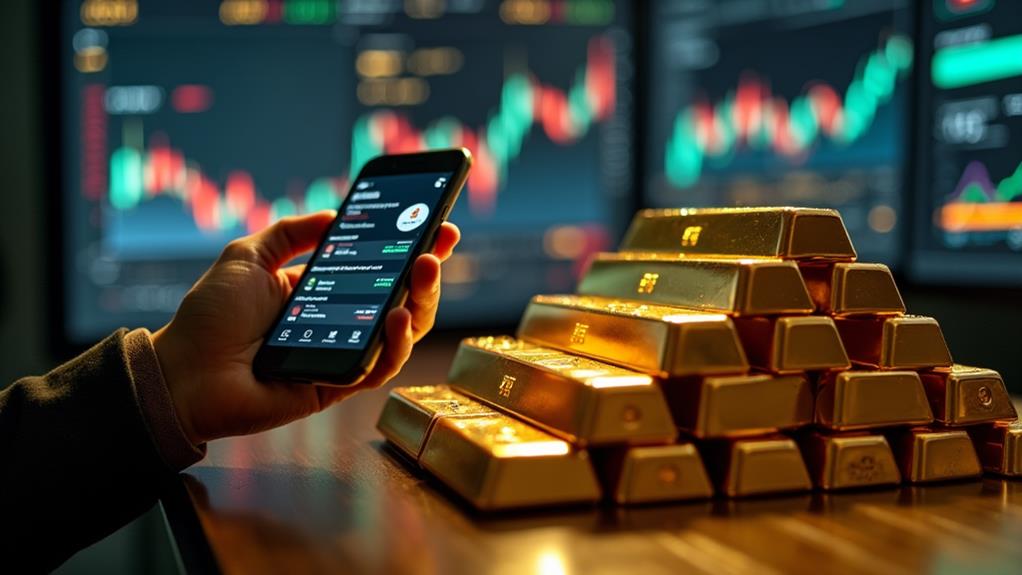Gold's allure as an investment traces back millennia, captivating civilizations with its lustrous beauty and fundamental value. From ancient Egyptian tombs to modern financial markets, this precious metal has maintained its status as a coveted asset. Understanding gold's progression from decorative adornment to economic cornerstone provides essential insights for novice investors. As we examine the origins of gold as an investment, we'll uncover the fascinating transformation that shaped its role in global finance and determine why it continues to hold a unique position in portfolios worldwide. This investigation will disclose the timeless appeal of gold and its enduring significance in the constantly changing landscape of wealth preservation.
Key Insights
- Ancient civilizations recognized gold's unique properties, using it as currency and a symbol of wealth.
- Gold transitioned from decorative material to a universal medium of exchange in ancient societies.
- Wealthy merchants and nobility historically accumulated gold as a store of value.
- Gold became viewed as a safe haven during economic uncertainties and a hedge against inflation.
- Modern investment options have expanded beyond physical gold to include stocks, IRAs, and ETFs.
Ancient History of Gold

Tracing the origins of gold's value uncovers its significance throughout human civilization.
Ancient civilizations recognized gold's unique properties, leading to its use as currency and a symbol of wealth. Gold mining and trade routes emerged, connecting distant lands and fostering economic growth.
In ancient Egypt, gold adorned pharaohs and temples, while Mesopotamian cultures used it for ornate jewelry.
Ancient Greece saw gold coins become a standardized form of currency, facilitating trade across city-states. The Roman Empire further solidified gold's role in commerce, minting coins that circulated throughout their vast territory.
As civilizations rose and fell, gold remained a constant store of value. Its scarcity, durability, and aesthetic appeal ensured its continued importance.
This historical context laid the foundation for gold's eventual emergence as a modern investment vehicle, demonstrating its enduring allure across millennia.
Gold's Monetary Evolution
Evolving from its ancient origins, gold's role in monetary systems underwent significant transformations throughout history. As civilizations developed, gold transitioned from a decorative material to a widely accepted form of currency.
The introduction of gold coins standardized trade, while the gold standard linked paper money to physical gold reserves. This evolution solidified gold's position as a store of value and investment vehicle.
Key aspects of gold's monetary evolution include:
- Emergence of gold as a universal medium of exchange
- Adoption of gold coins by ancient empires
- Implementation of the gold standard in modern economies
- Fluctuations in gold prices influencing global markets
- Shift from gold-backed currencies to fiat money systems
The history of gold as money demonstrates its enduring appeal as a hedge against economic uncertainty.
Understanding this evolution is essential for investors contemplating gold as part of their portfolio strategy.
Rise of Gold Investments

Gold's monetary evolution laid the foundation for its emergence as a popular investment vehicle. Throughout history, individuals and institutions have sought to invest in gold as a safe haven during economic uncertainties. The concept of gold investment dates back to the Middle Ages, when wealthy merchants and nobility began accumulating gold reserves.
As financial systems developed, the ability to buy gold became more accessible to the wider audience. The history of gold investment illustrates its enduring appeal as a precious metal and store of value.
Investors often turn to physical gold during times of market volatility, viewing it as a hedge against inflation and currency fluctuations. Nevertheless, it is crucial to note that while gold can be a valuable addition to a diversified portfolio, it should not be considered a guaranteed profit-generating asset.
Careful consideration and research are vital before deciding to invest in gold.
Economic Impacts of Gold
Throughout history, gold has exerted a profound influence on global economies, shaping monetary policies and international trade. The gold market's dynamics significantly impact various economic sectors, with the price of gold often reflecting global economic health.
Gold's role in investment portfolios remains essential, as investors seek to diversify and hedge against market volatility.
Key economic impacts of gold include:
- Fluctuations in gold spot price affecting currency values
- Gold mining companies' influence on job markets and local economies
- Investment in gold as a safe haven during economic uncertainties
- Gold exchange-traded funds impacting traditional investment strategies
- Demand for gold influencing industrial sectors and technological advancements
Gold futures and other gold-related financial instruments continue to play a significant role in modern economies.
As global markets evolve, understanding the economic impacts of gold becomes increasingly important for investors and policymakers alike.
Modern Gold Investment Strategies

Modern investment strategies involving gold have expanded significantly beyond traditional methods of physical ownership. Investors now have diverse options, including gold bullion, gold stocks, gold IRAs, and gold exchange-traded funds. The table below outlines essential investment strategies:
| Strategy | Pros | Cons |
|---|---|---|
| Gold Bullion | Direct ownership | Storage concerns |
| Gold Stocks | Market liquidity | Company-specific risks |
| Gold IRAs | Tax advantages | Regulatory restrictions |
| Gold ETFs | Easy trading | Management fees |
The gold rate and potential surge in gold prices influence investment decisions. While buying gold coins remains popular, it's vital to consider storage and authenticity. Each way of investing in gold carries unique risks and benefits. Investors should carefully evaluate their financial goals, risk tolerance, and market conditions before committing to any gold investment strategy. Consulting with financial advisors can provide valuable insights into incorporating gold into a diversified portfolio.
My Final Thoughts
Gold's voyage from ancient treasure to modern investment vehicle reflects humanity's enduring fascination with this precious metal. Like a unwavering anchor in turbulent seas, gold continues to provide stability and value in uncertain economic times. Its role has evolved, yet remains vital in diversified portfolios. As investors traverse the complex financial landscape, understanding gold's history and potential offers valuable insights. Nevertheless, caution and thorough research are fundamental when evaluating gold investments.







